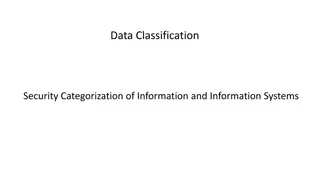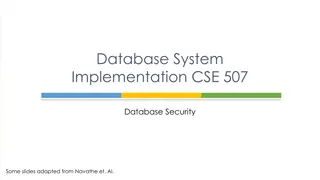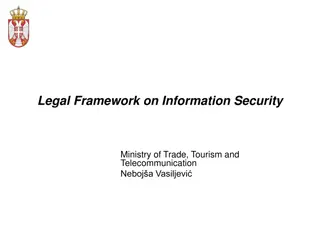Understanding Information Security and Confidentiality Measures
Explore the importance of information security and confidentiality in safeguarding official data. Learn about the CIA triad model, which focuses on confidentiality, integrity, and availability of information. Discover how sensitive personal data is defined under the Data Protection Act and the measures involved in safeguarding data confidentiality effectively.
Download Presentation

Please find below an Image/Link to download the presentation.
The content on the website is provided AS IS for your information and personal use only. It may not be sold, licensed, or shared on other websites without obtaining consent from the author. Download presentation by click this link. If you encounter any issues during the download, it is possible that the publisher has removed the file from their server.
E N D
Presentation Transcript
SECURITY AND SAFE KEEPING OF OFFICIAL INFORMATION Presented by: DOOKEE Padaruth (Data Protection Officer/ Senior Data Protection Officer) Date: Monday 28 November 2016 at 10:45 Venue: Lecture Room 641, Level 6, Fook House. Bourbon Street, Port Louis
THE MAIN ELEMENTS 1 Security and Safe Keeping of official information 2 Safekeeping of Documents 3 Classification of information 4 Other Security issues Other related laws for Security and safe Keeping of official information 5
SECURITY AND SAFE KEEPING OF OFFICIAL INFORMATION The aspect of Confidentiality and Security Safekeeping of Documents
The aspect of Information Security Confidentiality, integrity and availability, also known as the CIA triad, is a model designed to guide policies for information security within an organization. The elements of the triad are considered the three most crucial components of security. In this context, confidentiality is a set of rules that limits access to information, integrity is the assurance that the information is trustworthy and accurate, and availability is a guarantee of reliable access to the information by authorized people.
Confidentiality Confidentiality is roughly equivalent to privacy. Measures undertaken to ensure confidentiality are designed to prevent sensitive information from reaching the wrong people, while making sure that the right people can in fact get it: Access must be restricted to only those authorized parties to view or maintain the data in question as per their designated role. It is common, as well, for data to be categorized according to the amount and type of damage that could be done should it fall into unintended hands. More or less stringent measures can then be implemented according to those categories.
DEFINITIONS(Data Protection Act) Sensitive Personal Data Membership to Trade Union Religious / Similar Belief Physical / Mental Health Political Opinion / Adherence Sexual Preferences / Practices Sensitive Personal Data Racial / Ethnic Origin Criminal Convictions
Safeguarding data confidentiality Safeguarding data confidentiality may involve strong passwords and password-related best practices and information about social engineering methods, to prevent them from data-handling rules with good intentions and potentially disastrous results. Extra measures might be taken in the case of extremely sensitive documents, precautions such as storing only on very secured computers, Protected disconnected storage devices or, for highly sensitive information, in hard copy form only.
Integrity Integrity involves maintaining the consistency, accuracy, and trustworthiness of data over its entire life cycle. Data must not be changed in transit, and steps must be taken to ensure that data cannot be altered by unauthorized people (for example, in a breach of confidentiality). These measures include file permissions and user access controls. - Versioncontrol maybe used to prevent erroneous changes or accidental deletion by authorized users becoming a problem. In addition, some means must be in place to detect any changes in data that might occur as a result of non-human- caused events such as strong electromagnetic pulse (EMP) or file/ computer/server crash.
AVAILABILITY Availability is best ensured by rigorously maintaining all hardware, performing hardware repairs immediately when needed and maintaining a correctly functioning operating system environment that is free of software conflicts. It s also important to keep current with all necessary system upgrades. Safeguards against data loss or interruptions in connections must include unpredictable events such as natural disasters and fire. To prevent data loss from such occurrences, a backup copy may be stored in a geographically-isolated location, perhaps even in a fireproof, waterproof safe. Extra security equipment or software such as firewalls and proxy servers can guard against downtime and unreachable data due to malicious actions such as denial-of-service (DoS) attacks and network intrusions.
IMPORTANTDOCUMENTS Where do you keep your most important documents? Perhaps, you have a filing cabinet These might include: Passports Titles and Deeds Wills, Power of Attorney, Trusts Legal documents Birth certificates Marriage, and other certificates Bonds and other banking items When you have a central location where all important papers are kept, then you know exactly where to find them when you need them. Sounds simple. Yet, most people do not practice this easy organization tip.
DEFINITIONS(Cont.) Data Controller means a person who, either alone or jointly with any other person, makes a decision with regard to the purposes for which and in the manner in which any personal data are, or are to be, processed; The data controller can be the organisation, or can also be an individual if that individual is acting on his/her own initiative for example, doctors, lawyers or sole traders.
IMPORTANTDOCUMENTS 5 Tips to Help You Always Know - Where Your Most Important Documents Are: 1.All in One Location 2. Eliminate the Disorder 3. Digitize What You Can 4. Always Return Them 5. Keep Them Safe
5 TIPSTO HELP YOU ALWAYS KNOW WHERE YOUR MOST IMPORTANT DOCUMENTS 1. All in One Location Find one location or container to keep all of your most important documents. It can be a drawer, filing cabinet nearby or in the Registry. My important papers must be in file of a unique color, in order to identify them rapidly. 2. Eliminate the Disorder Be very selective about what goes in your important papers collection. There are very few documents that truly need to be in there. For example, receipts and other simple documents should be in their own filing cabinet. Think of your important papers as those that are Top Secret or non-replaceable.
5 TIPSTO HELP YOU ALWAYS KNOW WHERE YOUR MOST IMPORTANT DOCUMENTS 3 Digitize What You Can Your important papers box should only be for documents that must be in hard copy. For documents that don t explicitly need to be paper, scan them to your digital library. 4. Always Return Them When you do need an important document, make sure that you put it back as soon as you are done with it. Don t place it on other location. Always put it immediately back in the original place. 5. Keep Them Safe Keep your important papers file in a safe place. It should be separate from your normal every day files. For more protection, use lock & key, a fire safe to protect your papers from any risks.
Classification of information Classified information is material that a government body claims is sensitive information that requires protection of confidentiality, integrity, or availability. Access is restricted by law or regulation to particular groups of people, and mishandling can incur criminal penalties and loss of respect. Documents and other information assets are typically marked with one of several (hierarchical) levels of sensitivity e.g. restricted, confidential, secret and top secret. The choice of level is often based on an impact assessment governments often have their own set of rules which include the levels, rules on determining the level for an information asset, and rules on how to protect information classified at each level.
Common classification The two common classification schemes are government/military classification and commercial business/private sector classification. There are five levels of government/ military classification (listed here from highest to lowest): 1. Top secret 2. Secret 3. Confidential 4. Sensitive but unclassified 5. Unclassified
CLASSIFICATION (1) 1. The highest level of classification. Top secret The unauthorized disclosure of top secret data will have - drasticeffects and - cause grave damage to national security. 2. Secret Used for data of a restricted nature. The unauthorized disclosure of data classified as secret will have - significant effects and - cause critical damage to national security.
CLASSIFICATION (2) 3. Confidential Used for data of a confidential nature. The unauthorized disclosure of data classified as confidential will have - noticeable effects and - cause serious damage to national security. This classification is used for all data between secret and sensitive but unclassified classifications. 4. Sensitive but unclassified Used for data of a sensitive or private nature, - but the disclosure of this data would - not cause significant damage. 5. Unclassified The lowest level of classification. This is used for data that is neither sensitive nor classified. The disclosure of unclassified data does not compromise confidentiality or cause any noticeable damage.
CLASSIFICATION (3) The classifications of confidential, secret, and top secret are collectively known or labeled as classified . Often, revealing the actual classification of data to unauthorized individuals is a violation of that data. Thus, the term classified is generally used to refer to - any data that is ranked above the sensitive but unclassified level. All classified data is exempt from the - Freedom of Information Act as well as - many other laws and regulations.
OTHER SECURITYISSUES (a) Ensure that computers, applications, databases and servers using the HRMIS are password protected. It is recommended that passwords are of sufficient strength to deter password cracking or guessing attacks. A strong password includes numbers, symbols, upper and lowercase letters and is changed on a regular basis. (b) After a period of inactivity, ensure that computers are subject to password-protected lock out. Staffs should ensure that PCs are logged off or locked when left unattended for any period of time and user credential is required to access. (c) Ensure that computers and servers are - securely locked away from any unauthorised people.
SECURITYISSUES (d) Ensure that access controls are put in place and the correct designated role is assigned to you. Ideally, users should only have access to the specific data which they require in order to perform their duties. For sensitive personal data, i.e., racial/ethnic origin, political opinion/adherence, religious/similar belief, membership to trade union, physical/mental health, sexual preferences/practices and criminal convictions, it is recommended to use additional safeguards such as encryption and multi- level access controls. (e) Ensure that the security measures in place are up-to-date and effective, e.g. up-to-date antivirus & firewall software. (f) Ensure that an up-to-date firewall is available to protect systems connected to the internet.
SECURITYISSUES (g) Ensure that access to personal information is restricted on a need-to-know basis in accordance with defined policy governing data protection aspects, e.g., authorisation required when accessing certain modules in the HRMIS. (h) Ensure that Access granted has been provided to the user For example to the HRMIS the credentials have been provided to work there. For instance, swipe card and/or PIN technology to the room(s) in question could be used to record when, where and by whom the room was accessed and to ensure that no one is granted access by others credentials . (i) Any access to the system which is no longer in active use, and provides access to personal data in for eg the HRMIS, should be removed where such access is no longer necessary or cannot be justified.
S 27. DPA - SECURITYOFPERSONALDATA (1) A data controller shall (a) take appropriate security and organisational measures for the prevention of unauthorised access to, alteration of, disclosure of, accidental loss, and destruction of the data in his control; and (b) ensure that the measures provide a level of security appropriate to (i) the harm that might result from the unauthorised access to, alteration of, disclosure of, destruction of the data and its accidental loss; and (ii) the nature of the data concerned.
S28. DPA - DUTYTODESTROYPERSONALDATA (1) Where the purpose for keeping personal data has lapsed, the data controller shall (a) destroy such data as soon as reasonably practicable; and (b) notify any data processor holding such data. (2) Any data processor who receives a notification under subsection (1) (b) shall, as soon as reasonably practicable, destroy the data specified by the data controller.
S 29 DPA.UNLAWFULDISCLOSUREOFPERSONALDATA (1) Any data controller who, without lawful excuse, discloses personal data in any manner that is incompatible with the purposes for which such data has been collected shall commit an offence. (2) Any data processor who, without lawful excuse, discloses personal data processed by him without the prior authority of the data controller on whose behalf such data is or has been processed shall commit an offence. (3) Subject to subsection (4), any person who - (a) obtains access to personal data, or obtains any information constituting such data, without prior authority of the data controller or data processor by whom such data is kept; and (b) discloses the data or information to another person, shall commit an offence.
S 29 DPA.UNLAWFULDISCLOSUREOFPERSONALDATA (4) Subsection (3) shall not apply to a person who is an employee or agent of a data controller or processor and is acting within his mandate. (5) Any person who offers to sell personal data where such personal data has been obtained in breach of subsection (1) shall commit an offence. (6) For the purposes of subsection (5), an advertisement indicating that personal data is or may be for sale, constitutes an offer to sell the personal data shall commit an offence.
5. OTHERRELATEDLAWSFOR SECURITYAND SAFE KEEPINGOFOFFICIALINFORMATION
OTHERRELATEDLAWSFOR SECURITYANDSAFE KEEPINGOFOFFICIALINFORMATION Data Protection Act Computer Misuse and Cybercrime Act Electronic Transactions Act Official Secrets Act Information and Communication Technologies Act All the above can be downloaded from the internet at: http://mtci.govmu.org/English/Rules- RegulationsPolicies/Pages/default.aspx http://dataprotection.govmu.org/English/Pages/default.aspx http://ethicscorner.govmu.org/English/Documents/Regulatory/secretsac t.pdf























